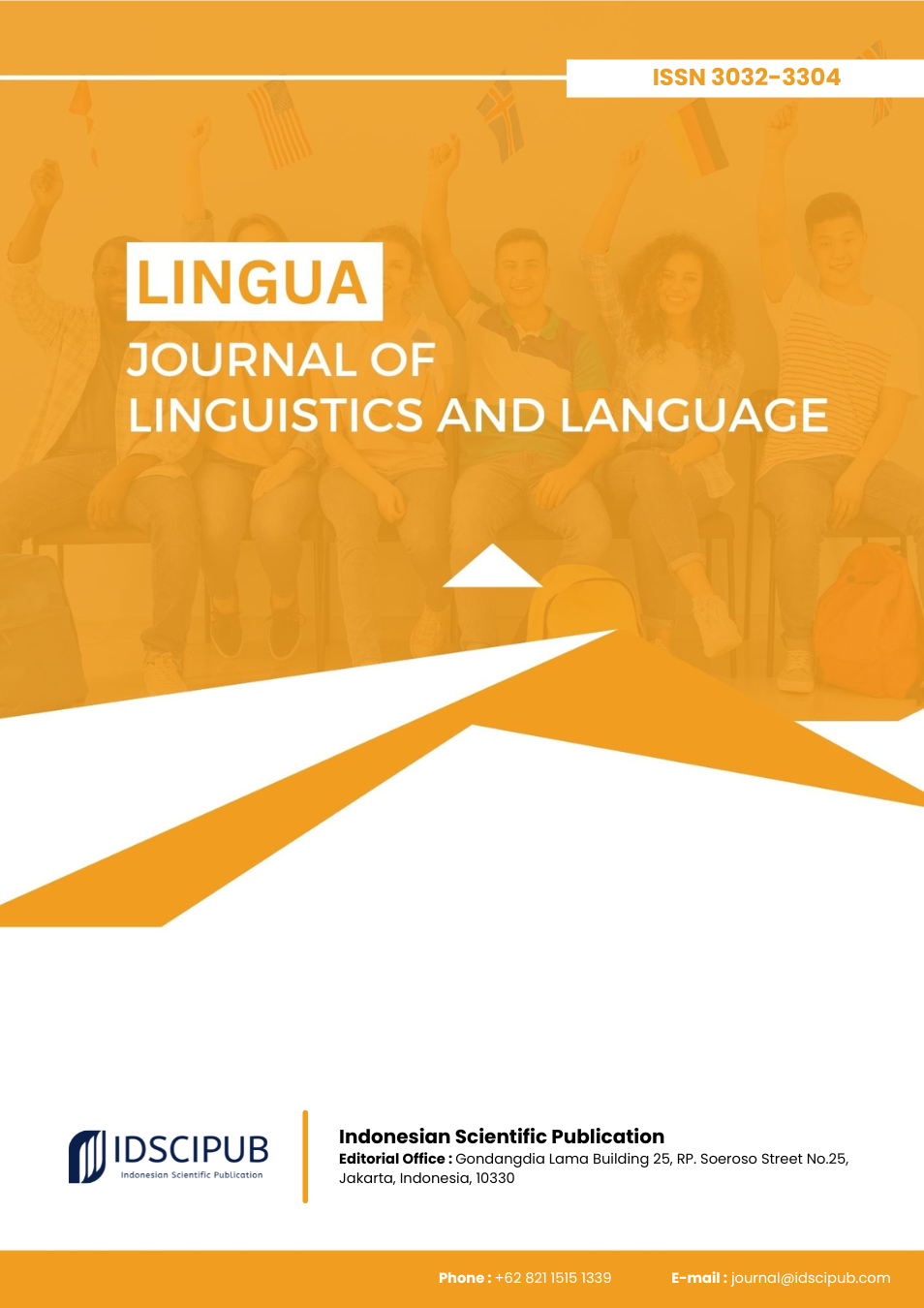Global Perspectives on Social Media and Language Evolution
DOI:
https://doi.org/10.61978/lingua.v2i4.1047Keywords:
Social Media, Language Change, Digital Linguistics, Neologisms, Semantic Shift, Translanguaging, Multilingual CommunicationAbstract
Social media has become a transformative force in global communication, accelerating processes of linguistic change in unprecedented ways. This review aims to synthesize current research on how digital platforms reshape language through neologisms, semantic shifts, non-standard grammar, and sociolinguistic dynamics. A systematic search was conducted across databases including Scopus, Web of Science, JSTOR, and Google Scholar, using targeted keywords and rigorous inclusion criteria. Studies employing both qualitative and quantitative methods were analyzed to capture a comprehensive picture of digital language evolution. Results indicate that platforms such as Twitter, TikTok, and Reddit foster distinctive forms of linguistic innovation shaped by technological affordances and community practices. Neologisms and acronyms emerge rapidly, semantic changes redefine meanings of common words, and syntactic flexibility challenges traditional norms. Sociolinguistic factors, particularly age and community identity, drive adoption, while systemic influences such as globalization and digital connectivity accelerate diffusion. These findings highlight not only the creative adaptability of language but also the challenges posed by polarization and the erosion of traditional registers. The discussion emphasizes the need for inclusive language policies, translanguaging pedagogy, and teacher training to address these shifts. Limitations in current research include insufficient focus on syntax, underrepresentation of non-Western contexts, and methodological challenges in analyzing unstructured digital data. Future research should address these gaps to enhance understanding of digital linguistics. By situating social media as both a mirror and catalyst of linguistic change, this study underscores its central role in shaping communication in the twenty-first century.
References
Abdulatief, S. and Guzula, X. (2024). Crossing the frontier from oral to written translanguaging for epistemic access in natural science. Reading & Writing, 15(1). https://doi.org/10.4102/rw.v15i1.507 DOI: https://doi.org/10.4102/rw.v15i1.507
Aleksić, G. and Garcı́a, O. (2022). Language beyond flags: teachers misunderstanding of translanguaging in preschools. International Journal of Bilingual Education and Bilingualism, 25(10), 3835-3848. https://doi.org/10.1080/13670050.2022.2085029 DOI: https://doi.org/10.1080/13670050.2022.2085029
Antony, S. and Tramboo, I. (2023). Digital metamorphosis: unraveling the evolution of global language in the technological culture. International Journal of English Language and Literature Studies, 12(4), 358-373. https://doi.org/10.55493/5019.v12i4.4921 DOI: https://doi.org/10.55493/5019.v12i4.4921
Becker, A. and Knoll, A. (2021). Establishing multiple languages in early childhood. Heritage languages and language hierarchies in German-English daycare centers in Switzerland. International Journal of Bilingual Education and Bilingualism, 25(7), 2561-2572. https://doi.org/10.1080/13670050.2021.1932719 DOI: https://doi.org/10.1080/13670050.2021.1932719
Beiler, I. (2020). Marked and unmarked translanguaging in accelerated, mainstream, and sheltered english classrooms. Multilingua, 40(1), 107-138. https://doi.org/10.1515/multi-2020-0022 DOI: https://doi.org/10.1515/multi-2020-0022
Brown, S. (2021). Emergent bilinguals as text designers: rendering meaning through signs. English Teaching Practice & Critique, 20(2), 130-148. https://doi.org/10.1108/etpc-07-2020-0076 DOI: https://doi.org/10.1108/ETPC-07-2020-0076
Cenoz, J. and Gorter, D. (2017). Minority languages and sustainable translanguaging: threat or opportunity?. Journal of Multilingual and Multicultural Development, 38(10), 901-912. https://doi.org/10.1080/01434632.2017.1284855 DOI: https://doi.org/10.1080/01434632.2017.1284855
Danjo, C. (2018). Making sense of family language policy: Japanese-English bilingual children's creative and strategic translingual practices. International Journal of Bilingual Education and Bilingualism, 24(2), 292-304. https://doi.org/10.1080/13670050.2018.1460302 DOI: https://doi.org/10.1080/13670050.2018.1460302
Duarte, J. (2016). Translanguaging in mainstream education: a sociocultural approach. International Journal of Bilingual Education and Bilingualism, 22(2), 150-164. https://doi.org/10.1080/13670050.2016.1231774 DOI: https://doi.org/10.1080/13670050.2016.1231774
Garcı́a, O. and Kleifgen, J. (2019). Translanguaging and literacies. Reading Research Quarterly, 55(4), 553-571. https://doi.org/10.1002/rrq.286 DOI: https://doi.org/10.1002/rrq.286
Gutierrez, A. (2024). The changing landscape of kapampangan vocabularies: a diachronic analysis. Research in Language, 22(2), 142-162. https://doi.org/10.18778/1731-7533.22.2.04 DOI: https://doi.org/10.18778/1731-7533.22.2.04
Hou, Z., Zhang, J., Jadallah, M., Enriquez‐Andrade, A., Tran, H., & Ahmmed, R. (2024). Translanguaging practices in global k‐12 science education settings: a systematic literature review. Journal of Research in Science Teaching, 62(1), 270-306. https://doi.org/10.1002/tea.22008 DOI: https://doi.org/10.1002/tea.22008
Jakonen, T., Szabó, T., & Laihonen, P. (2018). Translanguaging as playful subversion of a monolingual norm in the classroom. pp. 31-48. https://doi.org/10.1007/978-3-319-94851-5_3 DOI: https://doi.org/10.1007/978-3-319-94851-5_3
Parker, G., Botek, M., & Cabo, D. (2024). The evolving landscape of Spanish language representation in U.S. media: from overt to covert discrimination. Languages, 9(6), 220. https://doi.org/10.3390/languages9060220 DOI: https://doi.org/10.3390/languages9060220
Parra, M. and Proctor, C. (2021). Translanguaging to understand language. TESOL Quarterly, 55(3), 766-794. https://doi.org/10.1002/tesq.3011 DOI: https://doi.org/10.1002/tesq.3011
Petrova, Y. and Pervukhina, S. (2022). Socio-cultural changes influenced by information and communication technology. E3s Web of Conferences, 363, 04039. https://doi.org/10.1051/e3sconf/202236304039 DOI: https://doi.org/10.1051/e3sconf/202236304039
Radke, S., Vogel, S., Jasmine, Y., Hoadley, C., & Ascenzi‐Moreno, L. (2022). Emergent bilingual middle schoolers’ syncretic reasoning in statistical modeling. Teachers College Record, 124(5), 206-228. https://doi.org/10.1177/01614681221104141 DOI: https://doi.org/10.1177/01614681221104141
Shen, Y. (2024). Impact of social media on the evolution of English semantics through linguistic analysis. Forum for Linguistic Studies, 6(2). https://doi.org/10.59400/fls.v6i2.1184 DOI: https://doi.org/10.59400/fls.v6i2.1184
Wei, L. and Garcı́a, O. (2022). Not a first language but one repertoire: translanguaging as a decolonizing project. RELC Journal, 53(2), 313-324. https://doi.org/10.1177/00336882221092841 DOI: https://doi.org/10.1177/00336882221092841
Wen, Z., Han, L., Hu, G., & Teng, M. (2022). Rethinking language policy and planning in the Greater Bay Area of China: insights from translanguaging theory. Asian-Pacific Journal of Second and Foreign Language Education, 7(1). https://doi.org/10.1186/s40862-022-00167-0 DOI: https://doi.org/10.1186/s40862-022-00167-0
Yang, T., Xie, J., Li, G., Mou, N., Chen, C., Zhao, J., … & Lin, Z. (2020). Traffic impact area detection and spatiotemporal influence assessment for disaster reduction based on social media: a case study of the 2018 Beijing rainstorm. ISPRS International Journal of Geo-Information, 9(2), 136. https://doi.org/10.3390/ijgi9020136 DOI: https://doi.org/10.3390/ijgi9020136
Yun, S., Choi, S., Olğun-Baytaş, M., Lyu, S., & Croix, L. (2025). Enhancing learning for emergent bi/multilingual children through translanguaging pedagogies: a systematic literature review from 2010 to 2023. Contemporary Issues in Early Childhood. https://doi.org/10.1177/14639491251338422 DOI: https://doi.org/10.1177/14639491251338422
Zavalniuk, I., Bohatko, V., Pavlyuk, O., & Kukhar, N. (2024). A comparative study of expressive language usage in contemporary Ukrainian and English media. Multidisciplinary Science Journal, 6, 2024ss0707. https://doi.org/10.31893/multiscience.2024ss0707 DOI: https://doi.org/10.31893/multiscience.2024ss0707
Zhou, X., Huang, X., & Jili, H. (2020). Translanguaging in L3 Spanish classrooms: practices and attitudes. Círculo De Lingüística Aplicada a La Comunicación, 84, 65-75. https://doi.org/10.5209/clac.71996 DOI: https://doi.org/10.5209/clac.71996
Zhou, Y., Li, R., Chen, G., & Liu, H. (2022). Dynamics of language in social emergency: investigating COVID-19 hot words on Weibo. Glottometrics, 52, 1-20. https://doi.org/10.53482/2022_52_395 DOI: https://doi.org/10.53482/2022_52_395






